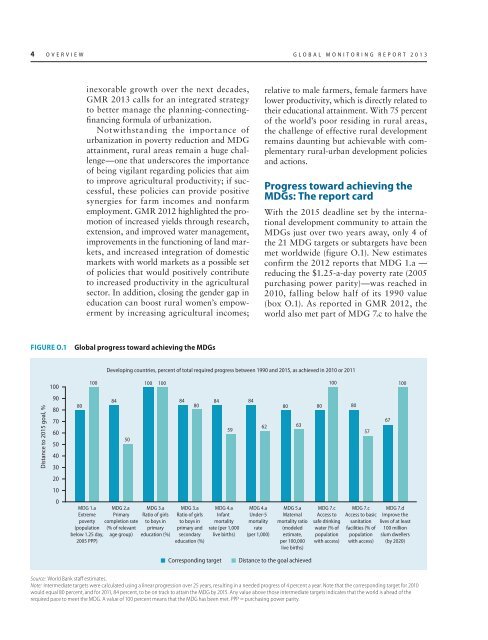rural-urban dynamics_report.pdf - Khazar University
rural-urban dynamics_report.pdf - Khazar University
rural-urban dynamics_report.pdf - Khazar University
You also want an ePaper? Increase the reach of your titles
YUMPU automatically turns print PDFs into web optimized ePapers that Google loves.
4 OVERVIEW GLOBAL MONITORING REPORT 2013<br />
inexorable growth over the next decades,<br />
GMR 2013 calls for an integrated strategy<br />
to better manage the planning-connectingfinancing<br />
formula of <strong>urban</strong>ization.<br />
Notwithstanding the importance of<br />
<strong>urban</strong>ization in poverty reduction and MDG<br />
attainment, <strong>rural</strong> areas remain a huge challenge—one<br />
that underscores the importance<br />
of being vigilant regarding policies that aim<br />
to improve agricultural productivity; if successful,<br />
these policies can provide positive<br />
synergies for farm incomes and nonfarm<br />
employment. GMR 2012 highlighted the promotion<br />
of increased yields through research,<br />
extension, and improved water management,<br />
improvements in the functioning of land markets,<br />
and increased integration of domestic<br />
markets with world markets as a possible set<br />
of policies that would positively contribute<br />
to increased productivity in the agricultural<br />
sector. In addition, closing the gender gap in<br />
education can boost <strong>rural</strong> women’s empowerment<br />
by increasing agricultural incomes;<br />
relative to male farmers, female farmers have<br />
lower productivity, which is directly related to<br />
their educational attainment. With 75 percent<br />
of the world’s poor residing in <strong>rural</strong> areas,<br />
the challenge of effective <strong>rural</strong> development<br />
remains daunting but achievable with complementary<br />
<strong>rural</strong>-<strong>urban</strong> development policies<br />
and actions.<br />
Progress toward achieving the<br />
MDGs: The <strong>report</strong> card<br />
With the 2015 deadline set by the international<br />
development community to attain the<br />
MDGs just over two years away, only 4 of<br />
the 21 MDG targets or subtargets have been<br />
met worldwide (figure O.1). New estimates<br />
confirm the 2012 <strong>report</strong>s that MDG 1.a —<br />
reducing the $1.25-a-day poverty rate (2005<br />
purchasing power parity)—was reached in<br />
2010, falling below half of its 1990 value<br />
(box O.1). As <strong>report</strong>ed in GMR 2012, the<br />
world also met part of MDG 7.c to halve the<br />
FIGURE O.1<br />
Global progress toward achieving the MDGs<br />
Developing countries, percent of total required progress between 1990 and 2015, as achieved in 2010 or 2011<br />
100<br />
100<br />
100 100<br />
100<br />
100<br />
Distance to 2015 goal, %<br />
90<br />
80<br />
70<br />
60<br />
50<br />
40<br />
30<br />
80<br />
84<br />
50<br />
84 84<br />
80<br />
59<br />
84<br />
62<br />
80<br />
63<br />
80<br />
80<br />
57<br />
67<br />
20<br />
10<br />
0<br />
MDG 1.a<br />
Extreme<br />
poverty<br />
(population<br />
below 1.25 day,<br />
2005 PPP)<br />
MDG 2.a<br />
Primary<br />
completion rate<br />
(% of relevant<br />
age group)<br />
MDG 3.a<br />
Ratio of girls<br />
to boys in<br />
primary<br />
education (%)<br />
MDG 3.a<br />
Ratio of girls<br />
to boys in<br />
primary and<br />
secondary<br />
education (%)<br />
MDG 4.a<br />
Infant<br />
mortality<br />
rate (per 1,000<br />
live births)<br />
MDG 4.a<br />
Under-5<br />
mortality<br />
rate<br />
(per 1,000)<br />
MDG 5.a<br />
Maternal<br />
mortality ratio<br />
(modeled<br />
estimate,<br />
per 100,000<br />
live births)<br />
MDG 7.c<br />
Access to<br />
safe drinking<br />
water (% of<br />
population<br />
with access)<br />
MDG 7.c<br />
Access to basic<br />
sanitation<br />
facilities (% of<br />
population<br />
with access)<br />
MDG 7.d<br />
Improve the<br />
lives of at least<br />
100 million<br />
slum dwellers<br />
(by 2020)<br />
Corresponding target<br />
Distance to the goal achieved<br />
Source: World Bank staff estimates.<br />
Note: Intermediate targets were calculated using a linear progression over 25 years, resulting in a needed progress of 4 percent a year. Note that the corresponding target for 2010<br />
would equal 80 percent, and for 2011, 84 percent, to be on track to attain the MDG by 2015. Any value above those intermediate targets indicates that the world is ahead of the<br />
required pace to meet the MDG. A value of 100 percent means that the MDG has been met. PPP = purchasing power parity.

















